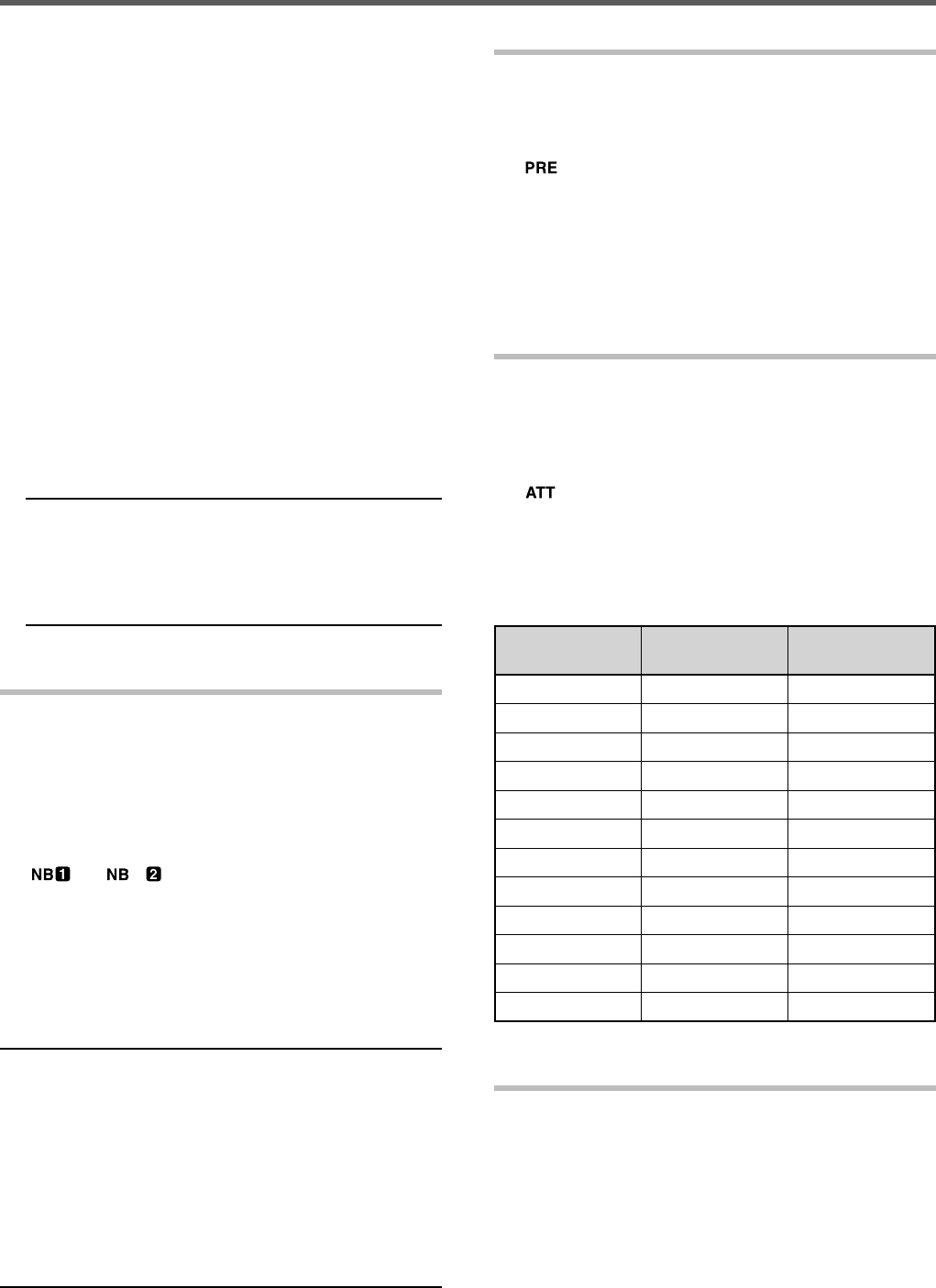
42
9 REJECTING INTERFERENCE
■ Setting the NR1 Level Adjustment
NR1 uses an adaptive fi lter to reduce the noise
element from the received signals. When the S/N
ratio is reasonably good in SSB, using NR1 will
improve the S/N further.
While NR1 is ON, you can further adjust the noise
reduction level by pressing and holding [NR (LEV)],
then turning the MULTI/CH control to select the
level from 1 to 10. The default is 5. The level is
saved separately for SSB/FM/AM and CW/FSK.
■
Setting the NR2 Time Constant
You can change the correlation time for NR2
(SPAC). When in SSB mode, select the correlation
time that allows you to hear signals with clarity.
When receiving CW, it is best to select the longest
correlation time that allows reliable reception. The
longer the correlation time, the better the S/N ratio.
When NR2 is ON, press and hold [NR (LEV)], then
turn the MULTI/CH control to select the correlation
time from 2 to 20 ms. The default is 20 ms.
Note:
◆ When using Noise Reduction 1 in SSB, FM, or AM
mode, the beat signal is suppressed along with the
normal signal. This is not a malfunction.
◆ Using Noise Reduction 2 in SSB mode may lower the
clarity of signals or induce pulse noise, depending on the
conditions.
NOISE BLANKER
The Noise Blanker is designed to reduce pulse noise
such as that generated by automobile ignitions. The
Noise Blanker does not function in FM mode.
• NB1 performs blanking through an analog circuit.
NB2 performs blanking using DSP.
Press [NB (LEV)] to cycle between Noise Blanker 1,
Noise Blanker 2, and OFF.
• “ ” or “ ” appears, depending on which
Noise Blanker is selected.
You can further adjust the Noise Blanker level from
1 to 10. The default level is 6. Press and hold [NB
(LEV)], then turn the MULTI/CH control to adjust the
Noise Blanker level.
• “NB LV.” and the current level appear on the
sub-display.
Note:
◆ The Noise Blanker is available only for SSB, CW, FSK, and
AM modes.
◆ Increasing the Noise Blanker level degrades the
intermodulation characteristics of the transceiver.
◆ For effective Noise Blanker operation, experiment with both
NB1 and NB2 on each band.
◆ When using Noise Blanker 2 and a CW signal is received,
there are times when the received signal may be distorted.
This is not a malfunction.
◆ While operating the Noise Blanker 2, if a strong signal is
received, the Blanking effect will decrease. In theory, this is
how the operation should perform; it is not a malfunction.
PRE-AMPLIFIER
Switching the pre-amplifi er OFF may help reduce
interference from adjacent frequencies.
Press [PRE (ANT 1/2)] to toggle the pre-amplifi er ON
and OFF.
• “
” appears when this function is ON.
The ON/ OFF setting will be automatically stored in
the current band. Each time you select the same
band, the same setting will be automatically selected
The frequency range of each band is provided in the
table below (under “ATTENUATOR”).
ATTENUATOR
The Attenuator reduces the level of received
signals. This function is useful when there is strong
interference from adjacent frequencies.
Press [ATT (RX ANT)] to toggle the attenuator ON
and OFF.
• “ ” appears when this function is ON.
The ON/ OFF setting will be automatically stored
in the current band. Each time you select the
same frequency band, the attenuator setting will be
automatically recalled. The frequency range of each
band is shown below.
Frequency
Band (MHz)
Pre-amplifi er
(Default)
Attenuator
(Default)
0.03 ~ 0.522 OFF OFF
0.522 ~ 2.5 OFF OFF
2.5 ~ 4.1 OFF OFF
4.1 ~ 6.9 OFF OFF
6.9 ~ 7.5 OFF OFF
7.5 ~ 10.5 ON OFF
10.5 ~ 14.5 ON OFF
14.5 ~ 18.5 ON OFF
18.5 ~ 21.5 ON OFF
21.5 ~ 25.5 ON OFF
25.5 ~ 30.0 ON OFF
30.0 ~ 60.0 ON OFF
CW REVERSE (RECEPTION)
This function pivots the BFO from the default position
(USB) to another position (LSB) in CW mode. It is
sometimes effective to remove the interfering signals
from the IF passband by pivoting the BFO.
1 Press [CW/FSK (REV)] until “CW” appears.
2 Press and hold [CW/FSK (REV)].
• “CW” changes to “CWR”.
3 To recover the default BFO position, press and
hold [CW/FSK (REV)] again.
• “CWR” changes to “CW”.


















